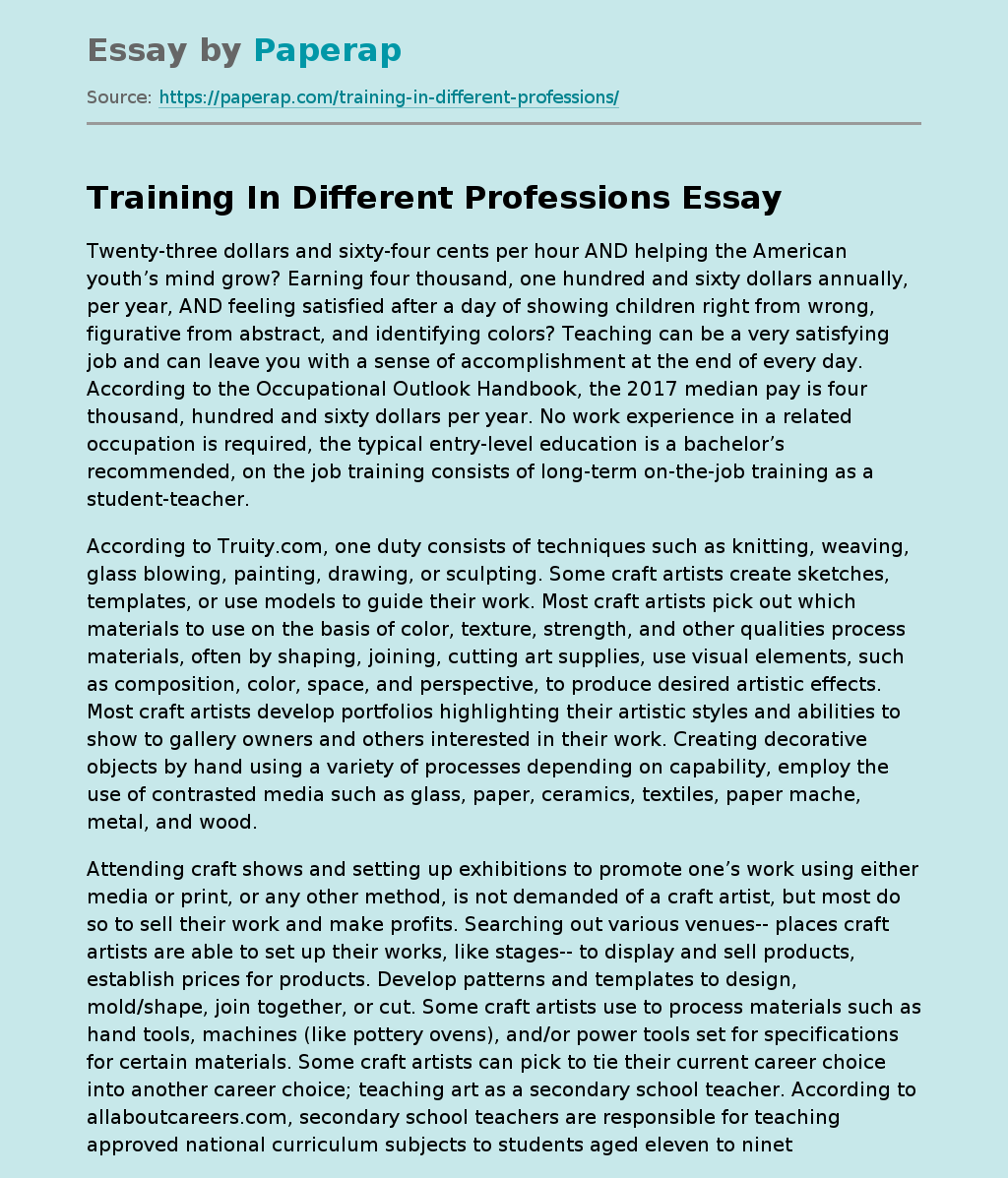Training In Different Professions
Twenty-three dollars and sixty-four cents per hour AND helping the American youth’s mind grow? Earning four thousand, one hundred and sixty dollars annually, per year, AND feeling satisfied after a day of showing children right from wrong, figurative from abstract, and identifying colors? Teaching can be a very satisfying job and can leave you with a sense of accomplishment at the end of every day. According to the Occupational Outlook Handbook, the 2017 median pay is four thousand, hundred and sixty dollars per year.
No work experience in a related occupation is required, the typical entry-level education is a bachelor’s recommended, on the job training consists of long-term on-the-job training as a student-teacher.
According to Truity.com, one duty consists of techniques such as knitting, weaving, glass blowing, painting, drawing, or sculpting. Some craft artists create sketches, templates, or use models to guide their work. Most craft artists pick out which materials to use on the basis of color, texture, strength, and other qualities process materials, often by shaping, joining, cutting art supplies, use visual elements, such as composition, color, space, and perspective, to produce desired artistic effects.
Most craft artists develop portfolios highlighting their artistic styles and abilities to show to gallery owners and others interested in their work. Creating decorative objects by hand using a variety of processes depending on capability, employ the use of contrasted media such as glass, paper, ceramics, textiles, paper mache, metal, and wood.
Attending craft shows and setting up exhibitions to promote one’s work using either media or print, or any other method, is not demanded of a craft artist, but most do so to sell their work and make profits.
Searching out various venues– places craft artists are able to set up their works, like stages– to display and sell products, establish prices for products. Develop patterns and templates to design, mold/shape, join together, or cut. Some craft artists use to process materials such as hand tools, machines (like pottery ovens), and/or power tools set for specifications for certain materials. Some craft artists can pick to tie their current career choice into another career choice; teaching art as a secondary school teacher. According to allaboutcareers.com, secondary school teachers are responsible for teaching approved national curriculum subjects to students aged eleven to nineteen.
If one wished to enter this incredibly important profession, one would be responsible for preparing lesson plans and teaching pupils in accordance with the state curriculum. One would also be responsible for marking their student’s work and providing them with needed feedback, criticism, encouragement, and support. Teachers also need to keep their skills crisp. One would be required to keep up to date on new teaching methods and developments in the curriculum. One would regularly be in contact with other teaching colleagues, administrators, and teaching assistants in order to provide every student with a well-rounded, quality education. According to tobecomeateacher.org, “a teacher is a professional who is responsible for the education and also the instruction of others, who should often concentrate on teaching a specific grade level or subject. During their education, prospective teachers may gravitate towards earning a specific degree, such as a Bachelor’s in Early Childhood Development.”
The easiest way to tie in your creative side with your teaching career is to become an art teacher. Decorative designs, such as painting on a canvas and/or paper, and hand-crafted masks are just a couple examples of several activities created to support visual arts teaching while also making fun and/or a silly disguise. The children will cut and glue objects you’ve picked out– sequins, beads, yarn– to create a mask. The lesson can be created with the simplest of materials, the most important being scissors, cardboard, masking tape and paints. A bachelor’s degree and a year or two (depending on where one is located and what grade one is looking at teaching) training as a student-teacher. A doctorate is often required to teach post-secondary.
Other requirements include state licensure and continuing the education to maintain licensure. Undergraduate training programs, which can lead to a bachelor’s degree, can vary depending on the teacher’s specialization. Training programs for aspiring grade school teachers provide them with acumen into the best methods for teaching contrasting subjects. Secondary school teachers usually just teach only one subject and could possibly earn double majors in both education and the other subject(s) area they teach. Secondary education for teaching used to not be a requirement in the past; likewise, few people were educated past the basics of grade school (pre-kindergarten through fourth grade). However, as schools became compulsory and freely attended, the number of students enrolled grew immensely.
Expectations also changed in the level of required education, which required teachers to be skilled in certain subject areas. This led to the education system that we all know of today. Teachers are required to complete an educator program prior to being licensed and a teacher preparation program– teaching credentials in order to be considered a legal public school teacher for secondary school teaching. In conclusion, teaching is not an easy job to accomplish, but not impossible to overcome, either. A bachelor’s degree, as stated many times in this essay, is needed at the minimum, some long-term training such as educator and teacher preparation programs are mandatory, and all in all the pay is liveable, not to mention the mental satisfaction.
Training In Different Professions. (2021, Dec 10). Retrieved from https://paperap.com/training-in-different-professions/

